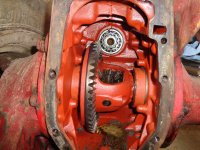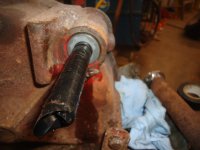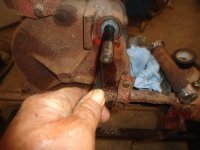How much pedal do you have..?? Good pedal, but like stepping on aplum, but no braking action, or do pedals go nearly to the floor..?? If pedals go to the floor, the master cylinders need brake fluid. With that being said, if they are low, there's a good chance brake lines need replaced, because they are leaking,or bad wheel cylinders. There are two seperate types of lines, going to each wheel cylinder. The first part out of the M/C's are steel lines, that have numerousbends in them. The second short one is just before the wheel cylinder, and is part rubber flex line. Case did have these preformed 10 years ago, but were $75 ea. I'm sure they are more now, but you can check. I bought a brake line flaring tool from Eastwood
Eastwood Brake Line Flaring Tool Kit for Professionals and bulk NiCopp line, and assorted fittings from Advance Auto Parts, and made my own.
https://shop.advanceautoparts.com/p...-16-x-25-cnc-325/16190029-P?searchTerm=NiCopp. The good news, they now make NiCopp lines in various length
https://shop.advanceautoparts.com/p...-cn-372-5-cn-372/22190271-P?searchTerm=NiCopp, you can bend your own, and save buying the tool. You can use regular steel line, but the NiCopp bends so much easier.
At the time, no one offered the short flex line. Since you now have your parts manual, with part number, you can do a Google search, and check. At that time, I lucked out and found one on ebay for $10. The other I had to buy through a dealer, but discovered buying the same part through a Case/IH Agriculture dealer, it was 10% less. Seems they were like $25+ at the time, through an AG dealer. I always do a Google search on part numbers, and through Ebay, you never know what someone has on there.
If you have plenty of pedal, but no braking action, more then likely the bull pinion cage seal is out, and has the brake disc's soaked with oil. Easiest way to check that, is to look below the brake housings for oil (90 wt) dripping from them. Gear oil has a distinct smell, so you know for sure if that is the problem. Since you have a service manual, it should show you the step by step procedure, on how to replace the seals. These are a common seal, and can be bought through a bearing supply, and/or probably NAPA. 10 yearsago, they were like $15 ea. through Motion Industries, maybe a buck or two more through NAPA, and WAY more then that through Case. Again, run the part number through Case Construction, Case/IH, Google, and Ebay. Takes a few minutes, but can save you some serious bucks.
If in fact, the seals are leaking, and you need to replace the seals, you'll need to drain the differential. I don't know if the diffy has a dip stick on it to check the fluid level or not. If it looks milky, you ought to do a transmission flush. Drain the diffy, I let mine drain over night. Replace the plug, then fill with 2,gallons of diesel fuel, and 2, gallons of ATF, and a quart, or two, of rubbing alcohol. 90% alcohol is best if you can find it. Tough to find since this Covid thing, and mostly 70% in pints now. Drive it around for 5-10 minutes to get things sloshed around. ATF is high detergent, and willclean things up. Diesel will thin it out, has some lube properties, and wash contaminants to the bottom. The rubbing alcohol will absorb any moisture left in there, and will take it out when you drain it. I just did this to my little IH 140 tractor a few months ago. One of the pictures below shows how well it cleaned things up. Maybe pour another gallon or two of diesel though to flush anything laying in the bottom, and wash it out.
In the service manual, it should tell you to only do one side at a time, to prevent the internal differential parts from dropping. The small tapered head screws that hold thebull pinion shaft housing, which holds the seal to be replaced, at least on the old 310B, had like #1 Phillips head screws. I replaced them with hex type Gr. 5 (Allen wrench) from Fastenal, which I think come in packs of 10. Seems like they are only torqued to around 10-15 inch pounds.
The bearing cage housing with new seal installed, needs to be slipped over the splined brake shaft. In your manual, it SHOULD tell you, you need some sort of shim stock to put around the shaft, to keep inverting the lip on the seal. That one at the time stumped me, as I had notin come to mind to use. I posed that question, possibly here, or on another forum. A retired mechanic came to my rescue. Start at the back side of the shaft, beyond the splineswhere the smooth part of the shaft is, but outside where the seal rides that shaft, wrap the shaftwith electrical tape, and wrap outwards, beyond the end of the shaft, leaving about a 1" tail. Coat the tape with oil, then carefully slip the housing in over the shaft, turning it slightly back and forth. Wrapping from inwards, to outwards, leaves the lips of the tape to the inside, so the lip on the seal basically jumps over those lips, and does not catch. There should be shims behind those housings, so don't forget to put those on first. When the housing is in place, and torqued, grab the tape by the tail, and it will spiral right off. I put pictures of replacing a seal in one of my garden tractors below, to give you an idea, of how it works. I've probably installed 25-30 seals using this method, and have had 100% success. I buy contractor packsof electrical tape from Harbor Freight, or anywhere that has cheaper tape, and keep it in the tool box for jobs like this.
Now for the brake disc's themselves. They wiill more than likely be in decent shape, other than being oil soaked. You can take a simple propane torch, and literally boil the oil out of them. The brake linings are bonded to the steel center, and can take that type of heat. I was reluctant to try it, but after talking to more than several local Case owners, they told me they all did it. That leaking oil seal is just the nature of the beast, and they will all eventually do it.
I hung my brake disc's on a steel rod outsode the shop, and heated in acircular motion for probably 10 minutes each, until the oil stopped coming out. A full circle to get it heated up, then half circle at the top, working the oil towards the bottom. Just remember you need to do both sides. Once I got the oil out, I laid it off to the side to cool, and started on another one. For final cleanup, I sprayed it with brake cleaner, then buffed them with a gasket removal Roloc disc, but some finer grit sandpaper, like 180 grit will do the same. Just buff that waxy looking surface off. Or, just buy a new set of brake disc's. Mine would lock the wheels up, after using the above, "boil the oil out" method, so I was a pretty happy camper. Do whatever floats your boat...
If you would happen to need brake parts, from master cylinders, wheel cylinders, or any parts, like springs, expander balls for the braking mechanism, definitely check this place out, after looking at prices elsewhere.
Remanufactured Transmissions, Torque Converters, Engines - Joseph Industries The last time I ordered any parts from there, when entering part numbers, it was kind of hit,and miss onwhat they have listed. But, a call to the 1-800 number got me everything I needed, in short order. The woman I spke with knew her stuff on parts. Just make sure you have your part numbers in front of you, when inquiring. I have noidea where you arelocated, but they are located in Streetsborough, Ohio, about 100 miles North of me. If I called,and placed an order before 9:30-10:00 am, UPS was here with them the next day.
Hope you didn't fall asleep reading all of the above, just trying to help determine what may be the problem with your brakes, and what to expect. Since you have the manuals, it should make it a lot easier, to see what I tried to explain. And, all repairs can be done pretty much with a basic tool set. Tools such decent torque wrench's are a good investment, both in. lb. and ft. lb. if you're going to be working on machinery.



